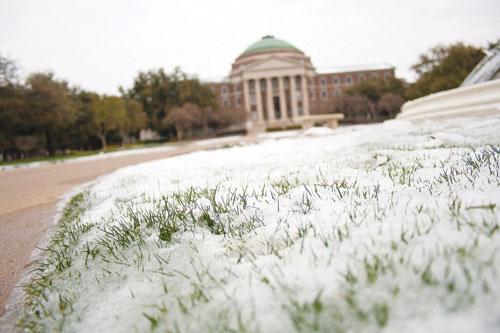
SMU cancels school for the third day in a row due to the icy conditions. (REBECCA HANNA/The Daily Campus)
For the first time in approximately 30 years, Southern Methodist University has been closed for three consecutive days, affecting the entire SMU community.
While many students have enjoyed the three-day break, faculty have been busy adjusting their syllabi and SMU Facility Services have been working on making campus safe and accessible.
Over the past three days SMU crews have spread around 10,000 pounds of chemical “ice melt” and are expecting another 7,500 pounds Thursday morning, according to Bob Casagrande, SMU director of facilities services.
“We’re trying to find sand, but supplies are low because there is such a huge area demand for it,” Casagrande said.
The first priority for spreading sand was on the porches of campus buildings and then walkways from residence halls to food service buildings, according to facilities services.
After being closed for two days due to an ice storm hitting the Dallas-Fort Worth area, SMU announced that it would be holding classes Thursday.
Students tweeted and updated Facebook statuses in protest to Provost Paul Ludden’s e-mail, which encouraged students to attend class and consider public transportation. However, he did say that students should e-mail professors for an excused absence if they live off campus and feel it is unsafe to commute to campus.
With approximately 10,000 students who commute to campus, Ludden said the responses to his e-mail are understandable.
“[The e-mail was] intended to address concerns among faculty, staff and students who must drive to campus,” Ludden said. “Because conditions did not improve significantly, and because of concerns addressed, SMU decided to close for [Thursday].”
Ludden is not solely responsible for the opening and closing of the school.
A committee of administrators that includes Vice President for Business and Finance Chris Casey, Associate Vice President Bill Detwiler, Vice President for Development and External Affairs Brad Cheves and Chief Rick Shafter consult before President R. Gerald Turner makes the final decision.
Since the decision has been made to close SMU, professors have had to adjust schedules to accommodate missed classes and scheduled quizzes, papers, tests and other assignments.
CCPA professor Rita Kirk has neither dropped this week’s course materials nor doubled up for next week.
“Students have been asked to keep up with their reading and course assignments,” she said. “I have asked them to use this down time to get ahead of the curve.”
Kirk also said she considered e-work; however, the power outages and rolling blackouts affected that approach.
Art History Professor Janice Bergman-Carton has not changed the syllabus. Instead, she has asked students “to do some independent learning for which they will be responsible on a quiz next week and for their midterm.”
Although professors have asked students to work ahead, many students have spent this “mini vacation” as a time to catch up on sleep and with friends.
“The first day I stayed in and watched movies all day, did some homework,” senior Victor Tapia said. “The second day I drank at my house with some friends.”
Junior Elizabeth Kirkpatrick has made herself comfortable on her couch.
“I have basically lived on my coach for the past three days and watched a ton of movies,” she said. “I also got to catch up on the TV shows I have been missing lately.”
While Kirkpatrick and Tapia have enjoyed a rather relaxing break, senior James Parker has been busy with work.
“I’ve been preparing for my GMAT and SMU graduate school application,” Parker said. “Additionally, I went to the men’s basketball game v. ECU and I had a blast!”
Because most students were iced in, finding food has been a challenge.
Tapia said his food options have not been healthy these past few days.
“Places are still closed and driving is a hassle,” he said.
Kirkpatrick agrees.
“Luckily Pizza Hut was delivering on Tuesday,” she said. “Other than that, I’ve been eating eggo waffles and my roommate made jambalaya last night.”
With temperatures staying below freezing and predictions of more snow, SMU crews have found it difficult to deal with the roads.
“The roads are the hardest part. The colder it gets, the more difficult it is for the chemical to do its job because it melts the ice, which then refreezes,” Casagrande said. “Until the temperature gets above 32, it will be difficult to clear the roadways and sidewalks.”








